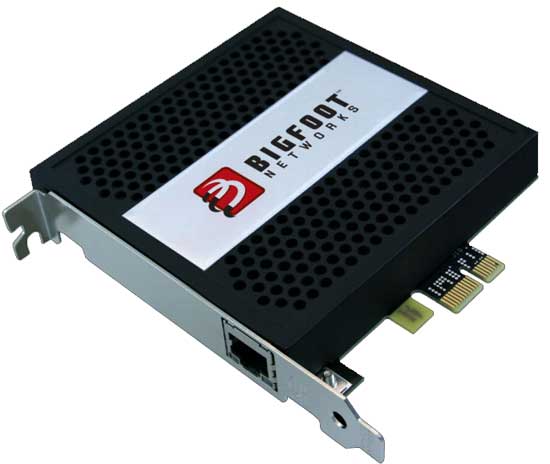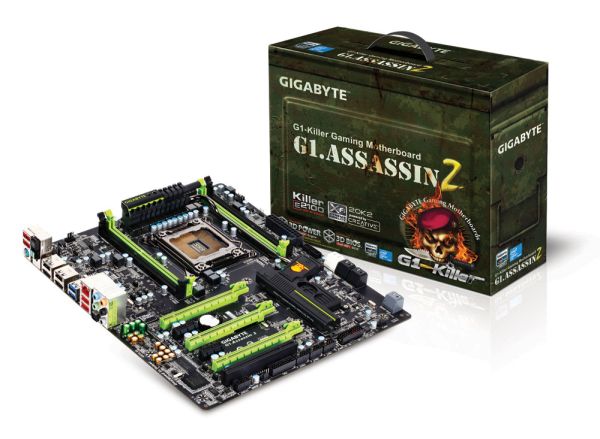Gigabyte's G1.Assassin 2 X79 Motherboard Features Killer NIC
by Jason Inofuentes on November 30, 2011 9:21 AM EST- Posted in
- Networking
- Killer
- Gigabyte
- Motherboards
- Bigfoot
- E2100
Previously offered on their G1.Sniper board, Qualcomm Atheros announced that their Killer E2100 NIC would once again make an appearance in Gigabyte's top gaming board, the X79-based G1.Assassin 2. The $399 motherboard is available now and is more gaming oriented than the UD5 board we're currently giving away. Housing just 4 DIMM slots provides more room for accessory chips, and the Killer E2100 is the kind of welcome feature that might not stand out like quad-GPU support or PWM count, but can provide some great benefits to users.
Bigfoot Networks originally developed the original Killer NIC and was acquired by Qualcomm Atheros (Atheros being another recent Qualcomm acquisition) earlier this year. The E2100 is not a new product, its hardware and software were first introduced last May in the Killer 2100 PCI-E card, and was integrated in Gigabyte motherboards and Asus graphics cards as the E2100. The hardware consists primarily of a 400 MHz PowerPC processor that runs a Linux instance and diverts network processing from the Windows stack, with the purpose of providing lower and more consistent pings in low latency applications, like gaming. Bigfoot, and now Qualcomm Atheros, also claim that diverting network processing to the NIC lightens the load on the CPU, but that's less of a concern when the CPU is a 6-core beast that's unlikely to be overly burdened by even the most demanding games.

What the Killer line definitely has going for it is the granular control the user has over their network traffic. Their Killer 2100/E2100 feature what's being called Advanced Stream Detection, the ability of the firmware to actually determine the type of traffic and assign it a priority based on its importance. In their example, Battlefield 3 players might have the game open on one display, the complimentary Battlelog app open in a browser on another display and providing voice chat services, and the Origin service running in the background downloading updates. The game's network traffic would be given a priority 1 status, the voice chat would receive priority 2, the app and browser priority 3, and downloading updates would be priority 4. Users can control stream priority manually through the Killer Network Management utility.
Given the performance we've seen from the Killer-N line, their wireless solution, we would love to see an update to the wired solution that would help justify the standalone NIC. As an integrated solution it becomes a little easier to consider, so long as you were intending on buying a high-end board to begin with. With CES just around the corner, we're hopeful we'll be able to see some new Killer products from the Qualcomm Atheros team.
Source: Gigabyte











12 Comments
View All Comments
Filiprino - Wednesday, November 30, 2011 - link
Serioulsy, why the motherboard heatsink has the shape of a gun?We're neither h4xx0rz nor 1337 m3g4 pr0 g4m3rZ.
etamin - Wednesday, November 30, 2011 - link
I agree, these gimmicky designs are getting way out of hand. Gigabyte desperately needs to find an artist for the job, not a gamer.compvter - Friday, December 2, 2011 - link
4 dimm slots these days is immediate no sale for me, and the icing in the cake is that damn gun that is just as stupid as some other board had heatsink that was shaped like few bullets. I mean ffs these boards are most likely been sold to ppl that are past toy guns. I agree with etamin, they should find artist or even better if they just get a guy who can make efficient heatsink, and just put those pretty pictures on the packaging so that customers don't have to "suffer" from them.surt - Wednesday, November 30, 2011 - link
Not buying a 4-memory-slot x79 board.Golgatha - Wednesday, November 30, 2011 - link
Me either. Any x79 board I buy, especially for $400, is going to have 8 memory slots.burningrave101 - Saturday, December 3, 2011 - link
What are you going to do with 8 memory slots other than install more RAM than 99% of end users, especially gamers and overclockers which is what boards like this one and the Gigabyte X79 UD7 and the upcoming Asus Rampage IV Formula are targeted at, are capable of making use of? All installing 8 DIMM's is going to do for you is limit your max RAM frequency to that of your worst module.If your someone that is building a workstation that could actually make use of over 16-32GB of RAM then you would be looking at something like the X79 UD5 which is marketed towards those types of users, not a gaming or extreme tweaking and overclocking motherboard.
code65536 - Wednesday, November 30, 2011 - link
Virtually all of the latency occurs after the traffic leaves your local network... and within a local network, latency is negligible to begin with.fatpat268 - Thursday, December 1, 2011 - link
I have to agree. While I'm sure benchmarks will show a difference, but in a real world application the difference will be hardly noticeable.Overall, I'm just surprised that the killer nic is still around.
yammerpickle2 - Thursday, December 1, 2011 - link
I believe they have been rehashing this same chip at this same frequency for a long time. I've only seen mixed reviews. Some reviews giving it a tiny advantage, and some showing it is actually slower. All in all I think spending the money for this chip on a stronger video card would be a better investment. I wish I could see some credible independent reviews that showed this was a definite cost effective benefit to a high end gaming rig, but I’m not aware of any.scoliosis - Sunday, December 18, 2011 - link
I remember back in the day Anandtech takes into account customer service when doing a review. Never really thought how important it is until now.Bought a Gigabyte motherboard and Channel A memory slot on the board is bad. RMA'ed it and took 3 weeks total from the time I shipped it to the time I got the board back. All they did was flash the BIOS to the latest revision and sent me the same board back! I immediately ran the same test as before and the system crashed within 3 minutes of booting up. Tried calling them 4 times this week and gave up after being on hold for over an hour. They don't do advanced RMAs either, so I'm stuck with a bad board again until I can get a hold of someone to RMA the board and wait 3 weeks then hope they actually replaced it.
Why don't Anandtech bring back the customer service portion of the review and compare the RMA policies between manufacturers? I had the pleasure of dealing with Asus in the past and they were excellent, offered to advanced RMA my board and even gave me a return shipping label to ship the bad board back! And that is after 1.5 years of use and the board was out of warranty!